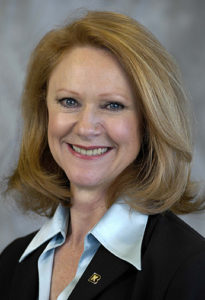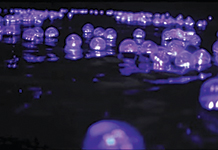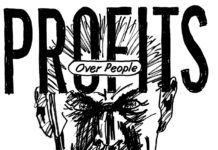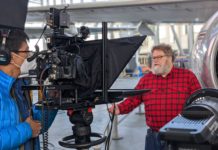Pub Note: This new column is part of the initiative to engage even more of the corporate folks who buy the products and services delivered by vendors in the marcomm community—especially those who advertise in MARKETING and on www.marketingnw.com. The columns will provide insights into timely marcomm topics, from a CMO perspective.
By Shannon Childs
With daily reports of the tragic episodes playing out in Aleppo, Syria on my mind, I was captivated by a recent CBS 60 Minutes report called The New Columbia. For anyone who’s not been following the events in this South American country (I confess that includes me), I would like to share with you the living proof that what we do—advertising and marketing—has real impact, beyond selling beer, burgers or banking services.
For more than half a century, the nation of Columbia was one of the most violent and isolated countries on planet Earth. Known for cartels, cocaine and kidnappings, Columbia had largely been forgotten by the outside world, a place to be avoided. And with good reason.
Over a period of five decades, civil war left 220,000 dead and five million displaced—and a third of the victims were children; humanity, caught in the cross-fire of political and warring opponents.
Various militant groups, most notably the Revolutionary Armed Forces of Columbia (FARC) attempted to overthrow the government in the longest-running war in the Western hemisphere. In just the last four years, more than 1,000 children were forcibly recruited by these armed groups, leaving 75 children dead and scores of schools seriously damaged by warfare.
Changing Minds. That all changed in 2016. After years of fighting, the Columbian military decided to try a new tactic: an advertising campaign. And while the 60 Minutes report dubbed this “one of the most unusual ideas in modern warfare,” I beg to differ.
Historically, many psychological techniques have been successfully implemented during wartime to influence and alter attitudes toward a specific cause. But what I found unique in this instance, brilliant really, was the decision to bring in an exceptional marketing and ad man. They hired Jose Miguel Sokoloff, a Columbia native and ad exec, to create a campaign to convince thousands of fighters to give up. 60 Minutes told Sokoloff’s story and revealed the common sense and compassion of the advertising campaigns that would end 52 years of war. Imagine. No bombs or bullets—just advertising!
How did Sokoloff do it? With Christmas trees, beams of light and soccer balls.
No Way Out. The government wanted to find a way to convince the guerrillas to surrender—and the Columbian people to accept them back. There would be no instant gratification; this required a decade of dedication and perseverance.
In 2006, Sokoloff was chosen for the mission with one purpose: to demobilize as many guerrilla fighters as possible. As with any successful ad campaign, his team began conducting thorough research. Their focus group was former guerrillas. They found through their research that there was a common denominator. The guerrilla was as much a prisoner of the organization as those he held hostage. There was no way out. Sokoloff and his team crafted several major campaigns, with the goal of demobilizing the fighters.
Campaign #1. In 2010, after four years of research and planning, they launched Operation Christmas and filmed it for commercials that played on TV. Led by Columbian Special Forces, Black Hawk helicopters carried Sokoloff’s colleagues into rebel territory. They located nine 75-foot-tall trees near guerrilla strongholds and decorated them with Christmas lights.
Equipped with motion detectors, the trees and a banner were lighted as the guerrillas walked by at night. The message: “If Christmas can come to the jungle, you can come home. Domobilize. At Christmas, everything is possible.” It worked! Nearly 5% of the force at that time (331) came out of the jungle and surrendered.

Campaign #2: Operation Rivers of Light. The team was challenged to reach its target market in 150,000 square miles of jungle. So they decided to uses rivers, the highways of the jungle, to carry the messge. They went to nearby villages and asked the people to write messages and send tokens that were packaged in small spheres that glowed in the dark. These capsules were released in a beautiful, irresistable floating sea of lights (see photos above). Result: 218 fighters gave up their weapons and came home, without anyone firing a shot.
Campaign #3: Football. According to Sokoloff, the most successful campaign was launched in 2011 when Columbia hosted the U-20 World Cup. Columbia’s passion for soccer is shared by everyone, including guerrillas. This campaign kicked off with soldiers entering the stadium armed with hundreds of soccer balls. Players, celebrities and fans signed them. The balls were loaded into helicopters and dropped over the jungle. A sticker on each ball read, “Demobilize. Let’s play again!”
Dozens of other campaigns were designed to show the guerrillas the way out: stickers on trees, beams of light and voices of former guerrillas broadcast across the jungle. But Sokoloff knew there is no more powerful voice than that of a mother.
In 2013, he found 27 mothers of guerrillas. They gave him photos of their sons and daughters as young children; photos that only they might recognize. During Christmas, the photos were placed all over the jungle with messages saying, “Before you were a guerrilla, you were my child. So come home. I will always be here for you at Christmastime.”
Through incredible humanity and creativity, Columbia, aided by a marketing genius, accomplished the near impossible—a war ended and a country transformed. In eight years, 18,000 guerrillas put down their weapons and came home, in large part because of Sokoloff’s campaigns.
On June 23, 2016, the Columbian government and the FARC rebels signed an historic ceasefire deal, bringing them closer to ending more than five decades of conflict. In October, President Juan Manuel Santos was awarded the Nobel Peace Prize for his efforts to end the 50-year-long civil war. And in November, the Columbian government and FARC signed a peace pact that was approved by their Senate and House of Representatives.
The 60 Minutes report is a excellent reminder that, as marketers, we possess the skills to evoke emotion, inspire others to action and create beams of light and hope in the jungle of life. And to quote Jose Miguel Sokoloff, “Advertising is a very, very powerful force in the good you can do in changing minds in certain ways.” Amen!
 Shannon Childs is the SVP/marketing for Kitsap Bank. You can reach her at schilds@kitsapbank.com. She oversees the Bank’s Philanthropic Program, as well as the award-winning edg3FUND small-business competition.
Shannon Childs is the SVP/marketing for Kitsap Bank. You can reach her at schilds@kitsapbank.com. She oversees the Bank’s Philanthropic Program, as well as the award-winning edg3FUND small-business competition.














